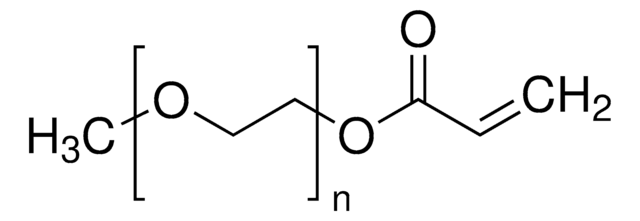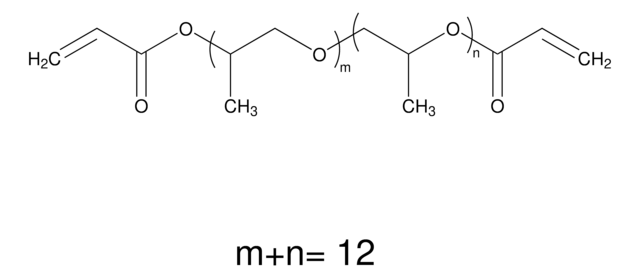729086
Poly(ethylene glycol) diacrylate
average Mn 1,000, acrylate, MEHQ as inhibitor (may contain)
Sinônimo(s):
Polyethylene glycol, PEG diacrylate
About This Item
Produtos recomendados
Nome do produto
Poly(ethylene glycol) diacrylate, average Mn 1,000, contains MEHQ as inhibitor
Formulário
solid
Nível de qualidade
peso molecular
average Mn 1,000
contém
MEHQ as inhibitor
≤1,500 ppm MEHQ as inhibitor (may contain)
composição
C2H3C(O)(OC2H4)nOC(O)C2H3
adequação da reação
reagent type: cross-linking reagent
reaction type: Polymerization Reactions
temperatura de transição
Tm 32-37 °C
Mw/Mn
≤1.1
Ω-final
acrylate
α-final
acrylate
arquitetura do polímero
shape: linear
functionality: homobifunctional
temperatura de armazenamento
−20°C
cadeia de caracteres SMILES
OCCO.OC(=O)C=C
InChI
1S/C8H10O4/c1-3-7(9)11-5-6-12-8(10)4-2/h3-4H,1-2,5-6H2
chave InChI
KUDUQBURMYMBIJ-UHFFFAOYSA-N
Procurando produtos similares? Visita Guia de comparação de produtos
Categorias relacionadas
Descrição geral
Aplicação
Nota de preparo
Palavra indicadora
Danger
Frases de perigo
Declarações de precaução
Classificações de perigo
Eye Dam. 1 - Skin Irrit. 2 - Skin Sens. 1
Código de classe de armazenamento
11 - Combustible Solids
Classe de risco de água (WGK)
WGK 1
Ponto de fulgor (°F)
Not applicable
Ponto de fulgor (°C)
Not applicable
Escolha uma das versões mais recentes:
Certificados de análise (COA)
Não está vendo a versão correta?
Se precisar de uma versão específica, você pode procurar um certificado específico pelo número do lote ou da remessa.
Já possui este produto?
Encontre a documentação dos produtos que você adquiriu recentemente na biblioteca de documentos.
Os clientes também visualizaram
Artigos
Progress in biotechnology fields such as tissue engineering and drug delivery is accompanied by an increasing demand for diverse functional biomaterials. One class of biomaterials that has been the subject of intense research interest is hydrogels, because they closely mimic the natural environment of cells, both chemically and physically and therefore can be used as support to grow cells. This article specifically discusses poly(ethylene glycol) (PEG) hydrogels, which are good for biological applications because they do not generally elicit an immune response. PEGs offer a readily available, easy to modify polymer for widespread use in hydrogel fabrication, including 2D and 3D scaffold for tissue culture. The degradable linkages also enable a variety of applications for release of therapeutic agents.
Devising biomaterial scaffolds that are capable of recapitulating critical aspects of the complex extracellular nature of living tissues in a threedimensional (3D) fashion is a challenging requirement in the field of tissue engineering and regenerative medicine.
Nossa equipe de cientistas tem experiência em todas as áreas de pesquisa, incluindo Life Sciences, ciência de materiais, síntese química, cromatografia, química analítica e muitas outras.
Entre em contato com a assistência técnica








